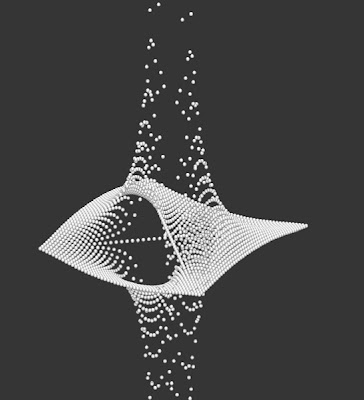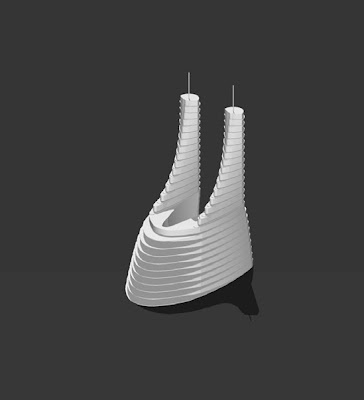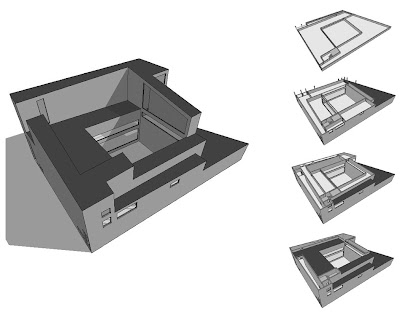these bicycles are placed in the courtyard following a basic program. in fact all those items are quite different from each other. and behaviour of the owners might have been different from each other too maybe? but some clever people implemented a program using iron rods that define the orientation and placement of the bicycles. you go there, and just squeeze your bicycle in between the others towards the specified direction. that's a simple program. environmental conditions create irregularities for sure, but as long as these nuisances keep themselves under a treshold, the basic formations do not change. there are additional programs though. for example when the ordering metal elements are all occupied, you just go and leave your bicycle next to some solid garden element, 'cause freestanding bicycles seem more susceptible to falling and being crushed. so you go and start the same program next to the concrete flowerbeds, perhaps this time it produces a little bit more noise. but for example when you try to start the same program next to the huge pole, the program may start to form a rather diagonal or spiralling formation, and this is also due to the perceived linear border that is adjacent... sometimes environmental conditions, like side-leaning bicycles with weird dimensions, or a fierce storm may exceed the treshold and help produce different patterns... also look at the colourful circular chair formations. that's another program. and you can easily discern the underlying rules. we're talking about social phenomena that work through several simple rules, that could be coded in a fashion that we could also include the inevitable "noise". and at one step, "even with this simple system", you could create formations that "feel like" random. the question is: is computation everywhere? (Stephen Wolfram, 'A new kind of science', 2002, makes me think of these...)
wolfram seems to have worked on cellular automata quite a lot -besides several other computational systems. there's another name, j.h. frazer, who commenced his evolutionary design studies with cellular automata (bkz. John Frazer, 'An Evolutionary Architecture', 1995). he developed a 3D cellular automaton, which was meant to produce 3D form. in each step, it was "growing" according to predetermined rules. the drawback (and the main idea) is, you only define the rules in the beginning. so he coined the phrase: "concept seeding". you have local rules, and global effects. and after overall arrangement is generated, you can use each cell as a definer for other forms, surfaces perhaps? but you can do it in a reverse fashion also, take a form, subdivide it and define all the sub-parts as nodes. and then manipulate nodes (think about 'finite element method', which is invoked by Frazer himself: Frazer, Frazer, Liu, Tang, Janssen, Generative and Evolutionary Techniques for Building Envelope Design, in Generative Art, 2002)
now there are a few visible stages. you generate or modify the form: the envelope, and then rationalize it, and then slice it into "floors". here comes "semantics", and, though quite simple, this is now distinguishable as a multi-phase design sub-system for architectural design.
There is also Janssen, who worked with Frazer for his PhD.. the study was about a generative evolutionary design system. following frazer, he developed the concept of ‘schema method', "... which requires the design team to participate in the programming of generative and evolutionary rules and representations. The method consists of two phases: in the first phase, the design team develops and encodes the essential and identifiable character of the designs to be generated and evolved; in the second phase, the design team uses an evolutionary system to generate and evolve designs that incorporate this character. ..." (Patrick Janssen, A generative evolutionary design method, in Digital Creativity, 2006, Vol. 17, No. 1, pp. 49–63) [i realized that i've downloaded this text via AÜ web resources, it should be through the account of özel or mahmut... now, here, i am finding almost every text that i am searching for just in seconds, and printing them if i like.. compare it with the days and days spent trying -and not achieving- to get just one particular text!]
a considerably different approach indeed: because now the ambition is not just shape formation, but "architectural design" proper, with all the goals, complexities, constraints and different sub-tasks. now it is no more 'local seeding'. but 'global programs' for designing are included, which seem more relevant for some of the sub-tasks. but still, there is a non-generic, task specific program, pre-given. limited number of tools, methods, a digital agent and a strategy pre-defined.
4. by the way, what is an evolutionary design system?
you have a generation, and you evaluate each of them and measure their fitness according to some criteria. according to the fitness of each individual, you decide it to die, or to mutate and go on living, or let it mate and have children, or combinations of these... and then you get another generation. this goes on as long as you like. each individual of a generation is indeed a candidate solution for a particular design problem. this way, by applying an environmental pressure in the guise of a fitness condition, you try to evolve designs. this might be altogether automated (which is what i like most), or interactive, mostly in the evaluation phase (which is more popular in design and art circles).
you have a generation, and you evaluate each of them and measure their fitness according to some criteria. according to the fitness of each individual, you decide it to die, or to mutate and go on living, or let it mate and have children, or combinations of these... and then you get another generation. this goes on as long as you like. each individual of a generation is indeed a candidate solution for a particular design problem. this way, by applying an environmental pressure in the guise of a fitness condition, you try to evolve designs. this might be altogether automated (which is what i like most), or interactive, mostly in the evaluation phase (which is more popular in design and art circles).







1 yorum:
öff bi daha uğraşmıycam şunun layoutuyla ya, üç saattir yazısıyla değil şunu bir düzgün göstersin diye uğraşıyorum ancak bu kadar oldu.. (a.q.u stt.mini)
Yorum Gönder